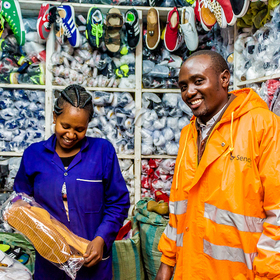
Sendy Logistics Challenge
The dataset provided by Sendy includes order details and rider metrics based on orders made on the Sendy platform. The challenge is to predict the estimated time of arrival for orders- from pick-up to drop-off.
Sendy provides an API as well as a web and mobile application platform to link customers who have delivery needs with vetted transporters. The customers select their vehicle of choice, get their price quote upfront and pay using various payment options. The system optimises the route, looks for the closest available riders and dispatches the orders in the most efficient way.
The training dataset provided here is a subset of over 20,000 orders and only includes direct orders (i.e. Sendy “express” orders) with bikes in Nairobi. All data in this subset have been fully anonymized while preserving the distribution. Furthermore, we have added data about the weather, that corresponds to the time of the order.
Additional datasets:
- Open street map - https://www.openstreetmap.org/#map=2/69.6/-74.9
- Open route service - https://maps.openrouteservice.org
- Uber Movement - https://movement.uber.com/cities/nairobi/downloads/speeds?lang=en-US&tp[y]=2018&tp[q]=4
- Here - https://developer.here.com/
- OSRM (Open Street Routing Machine) library
Variables
Order details
- Order No – Unique number identifying the order
- User Id – Unique number identifying the customer on a platform
- Vehicle Type – For this competition limited to bikes, however in practice, Sendy service extends to trucks and vans
- Platform Type – Platform used to place the order, there are 4 types
- Personal or Business – Customer type
Placement times
- Placement - Day of Month i.e 1-31
- Placement - Weekday (Monday = 1)
- Placement - Time - Time of day the order was placed
Confirmation times
- Confirmation - Day of Month i.e 1-31
- Confirmation - Weekday (Monday = 1)
- Confirmation - Time - time of day the order was confirmed by a rider
Arrival at Pickup times
- Arrival at Pickup - Day of Month i.e 1-31
- Arrival at Pickup - Weekday (Monday = 1)
- Arrival at Pickup - Time - Time of day the rider arrived at the location to pick up the order - as marked by the rider through the Sendy application
Pickup times
- Pickup - Day of Month i.e 1-31
- Pickup - Weekday (Monday = 1)
- Pickup - Time - Time of day the rider picked up the order - as marked by the rider through the Sendy application
Arrival at Destination times (column missing in Test set)
- Arrival at Delivery - Day of Month i.e 1-31
- Arrival at Delivery - Weekday (Monday = 1)
- Arrival at Delivery - Time - Time of day the rider arrived at the destination to deliver the order - as marked by the rider through the Sendy application
- Distance covered (KM) - The distance from Pickup to Destination
- Temperature -Temperature at the time of order placement in Degrees Celsius (measured every three hours)
- Precipitation in Millimeters - Precipitation at the time of order placement (measured every three hours)
- Pickup Latitude and Longitude - Latitude and longitude of pick up location
- Destination Latitude and Longitude - Latitude and longitude of delivery location
- Rider ID – ID of the Rider who accepted the order
- Time from Pickup to Arrival - Time in seconds between ‘Pickup’ and ‘Arrival at Destination’ - calculated from the columns for the purpose of facilitating the task
Rider metrics
- Rider ID – Unique number identifying the rider (same as in order details)
- No of Orders – Number of Orders the rider has delivered
- Age – Number of days since the rider delivered the first order
- Average Rating – Average rating of the rider
- No of Ratings - Number of ratings the rider has received. Rating an order is optional for the customer.
Join the largest network for
data scientists and AI builders